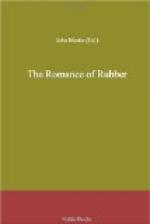The next step is to extract the particles of rubber from the latex and to harden them. The jungle method of hardening rubber is to dip a wooden paddle in the latex and smoke it over a fire of wood and palm nuts.[Footnote: See picture, page 12.] It is a back-breaking process to cover the paddle with layer after layer, until a good-sized lump, usually called a “biscuit,” is formed. The plantation method is a quicker and cleaner one. Into the vats is poured a small quantity of acid, which causes the rubber “cream” to coagulate and come to the surface. The “coagulum,” as it is called, is like snow-white dough. It is removed from the vats and run in sheets through machines which squeeze out the moisture and imprint on them a criss-cross pattern to expose as large a surface as possible to the air.
These sheets of rubber are then hung in smoke houses and smoked from eight to fourteen days in much the same way that we smoke hams and bacon. After being dried in this way they are pressed into bales or packed in boxes ready for shipment.
CHAPTER 8
A LAST WORD
It would be an adventure to follow a bale of plantation rubber as, carefully boxed or wrapped in burlap, it starts on its long and picturesque journey. Bullock carts, railroads, boats and steamers bring it at last to one of the world markets, Singapore, Colombo, London, Amsterdam or New York, where it is bought by dealers, and then sold to factories which make rubber goods.
An equally fascinating story might be told of its progress through the factory, how it is kneaded and rolled, mixed with chemicals, rubbed into fabrics, baked in ovens, and finally emerges as any one of the tens of thousands of articles that are made wholly or partly from rubber.
Rubber manufacturing is peculiarly an American industry. South America gave us the original rubber trees, and the one man who, more than any other, was responsible for making rubber useful was the American, Charles Goodyear. To-day, two-thirds of the entire output of rubber is sold to the United States, whose manufactured rubber goods set the standard for the whole world.
In spite of the wonders which rubber has already accomplished, and the adventures, which have colored its history, only the beginning of the romance of rubber has been told. The plantation industry is still in its infancy, and experiments are constantly being made to determine the best methods of planting, the most fruitful number of trees to the acre, the most advantageous way of tapping. In the laboratories of the great rubber manufacturers, scientists are at work improving old methods of using rubber and devising new ones.
Rubber is a substance of so many important characteristics that its uses are countless. It is used for certain purposes because it stretches, for others because it is airtight and watertight, for others because it is a non-conductor of electricity, for others because it is shock-absorbing, and for others because it is adhesive.




